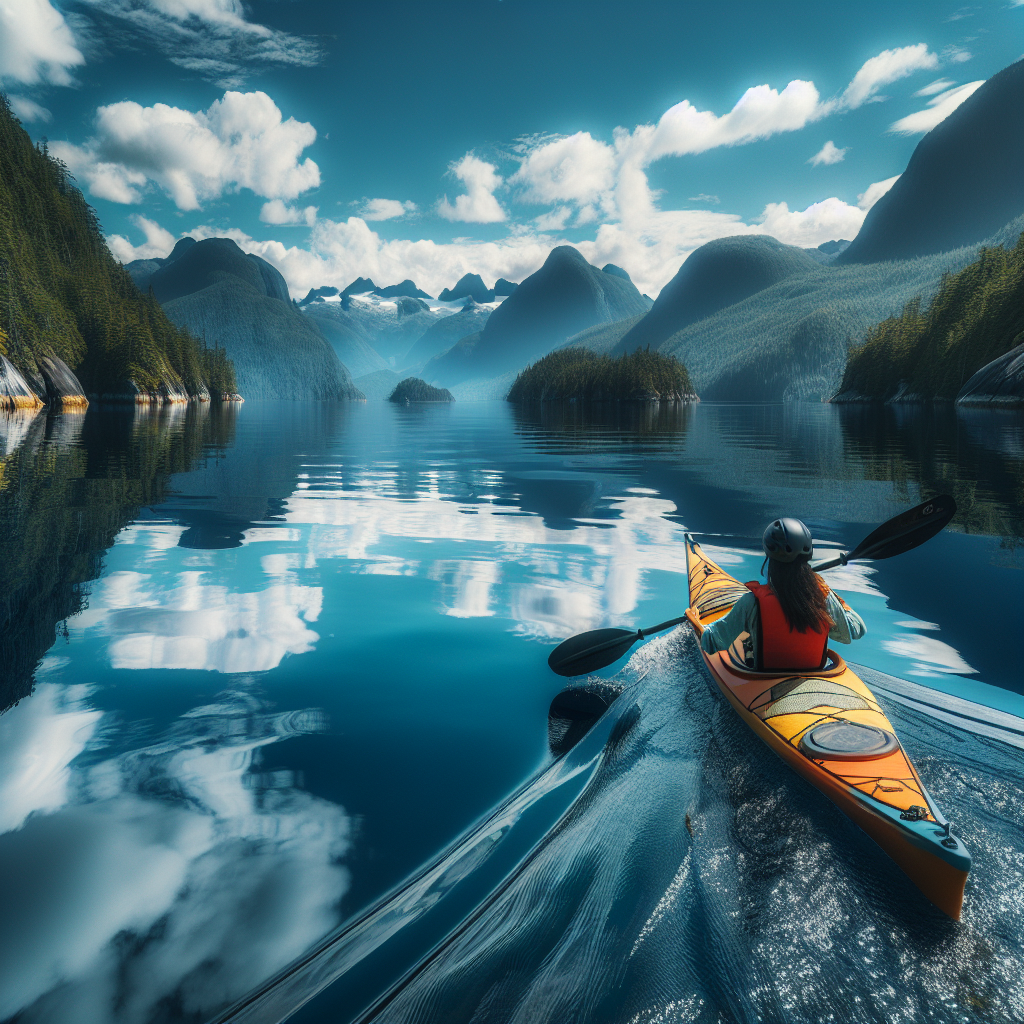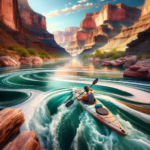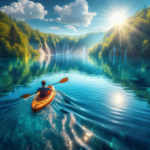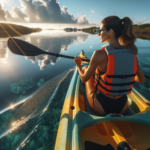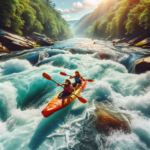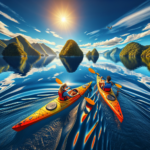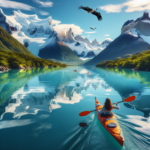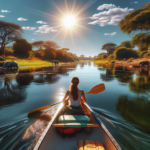Kayaking in Desolation Sound, Canada
Introduction to Kayaking
Kayaking is a popular outdoor activity that offers a unique blend of adventure, exercise, and a close connection with nature. Whether you’re paddling through serene lakes, navigating winding rivers, or exploring coastal waters, kayaking provides an exhilarating experience that appeals to both beginners and seasoned paddlers. The sport has grown in popularity over the years, attracting enthusiasts who seek the thrill of gliding through water while enjoying breathtaking landscapes.
This article aims to spotlight the unique features of kayaking in Desolation Sound, Canada, a destination that stands out for its stunning natural beauty and diverse kayaking opportunities. We’ll explore what makes this location a fantastic choice for kayaking enthusiasts, from its geographical features to the best spots for paddling. Additionally, we’ll cover essential information on safety, amenities, and environmental considerations to ensure a memorable and responsible kayaking experience.
Desolation Sound, located in British Columbia, Canada, is renowned for its pristine waters, dramatic coastal scenery, and abundant marine life. This area offers a unique kayaking experience that combines the tranquility of remote wilderness with the excitement of exploring hidden coves and islands. Whether you’re seeking a peaceful paddle or an adventurous expedition, Desolation Sound has something to offer every kayaker.
In the following sections, we’ll delve into the specifics of kayaking in Desolation Sound, including its geography, climate, and top kayaking spots. We’ll also provide practical information on safety regulations, amenities, and eco-friendly practices to help you make the most of your kayaking adventure in this remarkable destination.
Overview of Kayaking in Desolation Sound, Canada
Desolation Sound is situated on the northern end of the Sunshine Coast in British Columbia, Canada. This stunning area is characterized by its rugged coastline, sheltered bays, and numerous islands, making it an ideal location for kayaking. The sound is part of the larger Desolation Sound Marine Provincial Park, which spans over 8,000 hectares and offers a diverse range of marine and terrestrial environments to explore.
The climate in Desolation Sound is typically mild, with warm summers and cool, wet winters. The best time to visit for kayaking is during the summer months, from June to September, when the weather is most favorable, and the waters are calm. During this period, visitors can enjoy long daylight hours and relatively stable weather conditions, making it perfect for extended kayaking trips.
Accessing Desolation Sound is relatively straightforward. The most common way to reach the area is by taking a ferry from Vancouver to Powell River, followed by a short drive to the launch points at Okeover Inlet or Lund. Alternatively, visitors can opt for a scenic floatplane ride directly to the sound, offering a bird’s-eye view of the stunning landscape below.
Historically, Desolation Sound has been a significant area for the indigenous peoples of the region, who have used its waters for fishing and transportation for thousands of years. Today, the sound continues to be a popular destination for water sports enthusiasts, including kayakers, who are drawn to its natural beauty and rich cultural heritage.
Kayaking Conditions in Desolation Sound, Canada
Desolation Sound offers a variety of water conditions that cater to different kayaking preferences. The sound itself is a sheltered body of water, protected by the surrounding islands and mainland, which helps to keep the waters relatively calm. This makes it an excellent location for both novice and experienced kayakers looking to explore the area at their own pace.
The weather conditions in Desolation Sound can vary throughout the year. During the summer months, the weather is generally warm and dry, with temperatures ranging from 20 to 25 degrees Celsius (68 to 77 degrees Fahrenheit). This period also sees the least amount of rainfall, making it the ideal time for kayaking. In contrast, the winter months are cooler and wetter, with temperatures averaging around 5 to 10 degrees Celsius (41 to 50 degrees Fahrenheit) and frequent rain showers.
Tides and currents are important factors to consider when kayaking in Desolation Sound. The area experiences significant tidal fluctuations, with tides rising and falling by several meters each day. It’s essential for kayakers to be aware of the tide schedules and plan their trips accordingly to avoid being caught in strong currents or stranded on exposed tidal flats. Local tide charts and weather forecasts are valuable resources for planning safe and enjoyable kayaking excursions.
In addition to tides and currents, kayakers should also be mindful of other environmental factors such as wind and waves. While the sheltered nature of Desolation Sound helps to minimize wave action, strong winds can still create challenging conditions, particularly in more exposed areas. It’s always a good idea to check the weather forecast before heading out and to be prepared for changing conditions on the water.
Top Spots for Kayaking in Desolation Sound, Canada
Desolation Sound boasts several top spots for kayaking, each offering unique features and experiences. One of the most popular destinations is Prideaux Haven, a sheltered bay surrounded by lush forests and rocky shores. This area is known for its calm waters, making it an ideal spot for leisurely paddling and wildlife watching. Kayakers can often spot seals, otters, and a variety of bird species in the area.
Another must-visit location is Tenedos Bay, which offers stunning scenery and excellent opportunities for exploration. The bay is home to several small islands and coves, providing plenty of nooks and crannies to discover. The nearby Unwin Lake is also worth a visit, offering a refreshing freshwater swim after a day of paddling in the saltwater.
For those seeking a more challenging adventure, the Copeland Islands Marine Provincial Park is a fantastic option. This group of small islands is located just north of Lund and offers more exposed waters and rugged coastlines. The area is known for its diverse marine life, including sea stars, anemones, and colorful fish, making it a great spot for snorkeling and underwater exploration.
The best time of day for kayaking in Desolation Sound is typically in the morning or late afternoon when the winds are calmer, and the lighting is perfect for photography. During the summer months, early mornings and evenings also offer a chance to experience the tranquility of the sound without the crowds, providing a more intimate connection with nature.
Safety and Regulations
Safety is paramount when kayaking in Desolation Sound, and there are several local regulations and guidelines that visitors should be aware of. First and foremost, all kayakers are required to wear a personal flotation device (PFD) at all times while on the water. This is a crucial safety measure that can save lives in the event of an accident or capsize.
In addition to wearing a PFD, kayakers should also carry essential safety gear, including a whistle, a bilge pump, a paddle float, and a waterproof map of the area. It’s also advisable to bring a first aid kit, extra clothing, and plenty of water and snacks to stay hydrated and energized during your trip. For longer excursions, a marine VHF radio or a satellite phone can be invaluable for communication in case of emergencies.
Understanding and respecting the local marine environment is also important for safety. Kayakers should be aware of the potential hazards posed by tides, currents, and weather conditions, and plan their trips accordingly. It’s always a good idea to inform someone of your planned route and expected return time before heading out on the water.
In case of an emergency, it’s essential to remain calm and follow basic safety protocols. If you capsize, stay with your kayak and use your paddle float to re-enter the boat. If you’re unable to re-enter, signal for help using your whistle or VHF radio. In more serious situations, such as a medical emergency, contact local authorities or emergency services for assistance.
Amenities and Accommodations
Desolation Sound offers a range of amenities to make your kayaking adventure more enjoyable and convenient. Several rental facilities in the area provide high-quality kayaks, paddles, and safety gear for visitors who don’t have their own equipment. These rental shops often offer guided tours as well, providing valuable local knowledge and ensuring a safe and informative experience on the water.
For those looking to extend their stay, there are various accommodation options available in and around Desolation Sound. Camping is a popular choice, with several designated campsites located within the marine park. These sites offer basic amenities such as pit toilets and picnic tables, allowing visitors to immerse themselves in the natural beauty of the area while enjoying a rustic camping experience.
If you prefer more comfortable accommodations, there are several lodges, cabins, and bed-and-breakfasts in nearby communities such as Lund and Powell River. These establishments offer a range of amenities, from cozy rooms and home-cooked meals to guided kayaking tours and equipment rentals. Staying in these local accommodations also provides an opportunity to learn more about the region’s history and culture from knowledgeable hosts.
In addition to kayaking, Desolation Sound offers a variety of other recreational activities for visitors to enjoy. Hiking, fishing, and wildlife watching are popular pastimes, with numerous trails and viewpoints offering stunning vistas of the surrounding landscape. For those interested in marine life, snorkeling and scuba diving are excellent ways to explore the underwater world and observe the diverse marine species that inhabit the area.
Environmental Considerations
Preserving the natural habitats and wildlife of Desolation Sound is of utmost importance, and kayakers play a crucial role in maintaining the area’s ecological balance. Practicing eco-friendly kayaking is essential to minimize your impact on the environment and ensure that future generations can enjoy the beauty of Desolation Sound.
One of the key principles of eco-friendly kayaking is to follow the “Leave No Trace” guidelines. This means packing out all your trash, avoiding disturbing wildlife, and staying on designated trails and campsites. It’s also important to use biodegradable soap and avoid using harmful chemicals that can pollute the water.
Respecting wildlife is another critical aspect of eco-friendly kayaking. Keep a safe distance from marine animals such as seals, otters, and birds to avoid causing stress or disturbance. If you encounter wildlife while paddling, observe quietly and avoid making sudden movements or loud noises. Remember that you are a guest in their habitat, and it’s essential to minimize your impact on their natural behavior.
Supporting local conservation efforts is another way to contribute to the preservation of Desolation Sound. Several organizations and initiatives are dedicated to protecting the area’s natural resources and promoting sustainable tourism practices. By participating in these efforts, whether through donations, volunteer work, or simply spreading awareness, you can help ensure that Desolation Sound remains a pristine and vibrant destination for years to come.
Highlights
When comparing Desolation Sound to other popular kayaking destinations, several unique features stand out. One of the most notable aspects is the area’s incredible biodiversity. The sound is home to a wide variety of marine life, including seals, sea lions, dolphins, and even the occasional orca. The intertidal zones are teeming with colorful sea stars, anemones, and other fascinating creatures, making it a paradise for nature enthusiasts.
Geographically, Desolation Sound offers a diverse range of landscapes to explore. From sheltered bays and tranquil coves to rugged coastlines and forested islands, the area provides a stunning backdrop for kayaking adventures. The dramatic fjords and towering mountains that surround the sound add to its breathtaking beauty, creating a sense of awe and wonder for those who paddle its waters.
Historically, Desolation Sound holds significant cultural importance for the indigenous peoples of the region. The area’s rich history and cultural heritage are evident in the numerous archaeological sites and ancient petroglyphs that can be found along the coastline. Kayaking in Desolation Sound offers a unique opportunity to connect with this history and gain a deeper appreciation for the land and its people.
In terms of accessibility, Desolation Sound is relatively easy to reach compared to some other remote kayaking destinations. The proximity to major cities like Vancouver and the availability of transportation options such as ferries and floatplanes make it a convenient choice for both local and international visitors. This accessibility, combined with the area’s natural beauty and diverse kayaking opportunities, makes Desolation Sound a premier destination for paddlers of all skill levels.
FAQ Section
- What is the best season to go kayaking in Desolation Sound? The best season for kayaking in Desolation Sound is during the summer months, from June to September, when the weather is warm and the waters are calm.
- Are there beginner-friendly spots for kayaking in Desolation Sound? Yes, there are several beginner-friendly spots in Desolation Sound, such as Prideaux Haven and Tenedos Bay, which offer calm waters and sheltered conditions.
- What should I bring for a kayaking trip in Desolation Sound? Essential items include a personal flotation device (PFD), paddle, bilge pump, waterproof map, first aid kit, extra clothing, water, snacks, and a whistle.
- Are kayak rentals available in Desolation Sound? Yes, there are several rental facilities in the area that provide high-quality kayaks, paddles, and safety gear for visitors.
- How can I participate in local conservation efforts? You can support local conservation efforts by following eco-friendly kayaking practices, donating to conservation organizations, and participating in volunteer activities.
- Are guided kayaking tours available in Desolation Sound? Yes, guided kayaking tours are available and offer valuable local knowledge, ensuring a safe and informative experience on the water.
- What safety measures should I take while kayaking in Desolation Sound? Always wear a PFD, carry essential safety gear, check weather and tide conditions, inform someone of your planned route, and be prepared for emergencies.
Final Thoughts
Kayaking in Desolation Sound, Canada, is a truly unforgettable experience that offers a perfect blend of adventure, natural beauty, and cultural significance. The area’s diverse landscapes, abundant marine life, and rich history make it a premier destination for kayaking enthusiasts of all skill levels. Whether you’re seeking a peaceful paddle through sheltered bays or an adventurous expedition along rugged coastlines, Desolation Sound has something to offer everyone.
As you embark on your kayaking adventure, it’s essential to respect local guidelines and conservation efforts to preserve the pristine environment for future generations. By practicing eco-friendly kayaking and supporting local conservation initiatives, you can help ensure that Desolation Sound remains a vibrant and thriving destination for years to come.
In conclusion, Desolation Sound is a must-visit destination for anyone passionate about kayaking and the great outdoors. Its unique combination of stunning scenery, diverse wildlife, and rich cultural heritage provides an unparalleled experience that will leave you with lasting memories. So grab your paddle, pack your gear, and get ready to explore the beauty and thrill of kayaking in Desolation Sound, Canada.
We hope this article has inspired you to plan your next kayaking adventure in Desolation Sound. With its breathtaking landscapes, abundant wildlife, and welcoming community, it’s a destination that promises an unforgettable experience for all who visit. Happy paddling!

